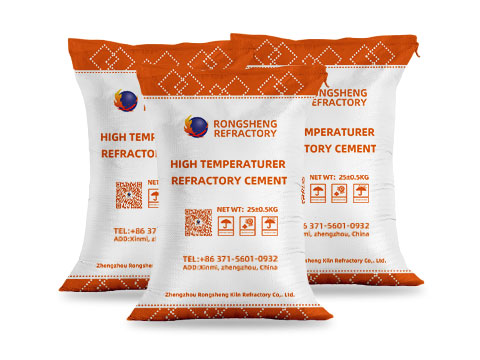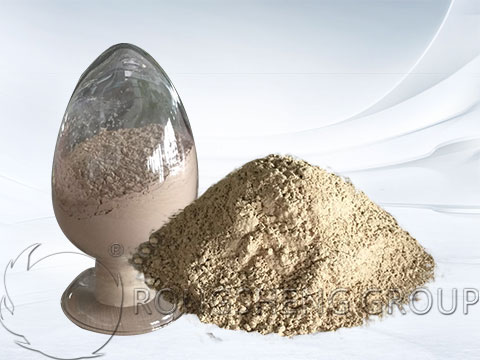Whether to use refractory mortar or refractory cement for boilers is a question full of doubts. Rongsheng refractory manufacturers, what is certain is that when laying refractory bricks on the boiler, the firebrick refractory mortar of the same material as the refractory bricks are generally used. Firebrick mortar is composed of refractory powder, binder, and admixture. Almost all refractory raw materials can be used to prepare refractory mortar. So what is refractory cement for boilers? How is boiler refractory cement used?

Boiler Refractory Cement
Boiler refractory cement is a raw material for unshaped refractory lining materials for boilers, which can be used to cement various refractory aggregates (such as corundum, calcined high-alumina bauxite, etc.). Used to prepare refractory mortar or refractory castable. Therefore, refractory cement is also called refractory castable cement.
Firebrick mortar is an ordinary refractory mortar made of refractory clinker powder plus an appropriate amount of plastic clay as a binder and plasticizer. Its normal temperature strength is low, and it has high strength only when it forms a ceramic bond at high temperatures. The chemically bonded refractory mortar uses hydraulic, air-hardening, or thermosetting bonding materials as a bonding agents. Before the temperature is lower than the formation of ceramic bonding, a certain chemical reaction occurs and hardens. Firebrick refractory mortar is mainly used in coke ovens, glass furnaces, blast furnaces hot blast stoves, and other industrial furnaces.
The usage of different refractory mortar is different. For casting clay, it is used at the burner of the kiln head. It is often used as a protective refractory layer, and it can also be used as a refractory material in some key parts of the preheater. The construction method is common grouting. For insulating fireclay, it can be used for trimming the deformation of the kiln shell. At this time, it only needs to be directly painted on the plane. Sometimes it also insulates the coolant ceiling. Thermosetting cement is common when laying bricks. We can directly use it for stirring and add a certain amount of glass water. In this way, the bonding strength and stability of the bricks will be improved to a certain extent.
Characteristics of Refractory Mortar
- Good thermal exfoliation.
- Good resistance to slag invasion.
- Good plasticity and convenient construction.
- High bonding strength and strong corrosion resistance.
- High refractoriness, up to 1650℃±50℃.

Furnace Refractory Cement Manufacturer
How to choose refractory cement manufacturers for boilers? Before that, we must first know what type of boiler we are using in our actual production. Because there are many kinds of boilers, such as gas boilers, heating boilers, power station boilers, etc., choose the appropriate refractory lining products according to different boilers. This can not only prolong the service life of the kiln lining but also save production costs for the enterprise.
Large boilers such as utility boilers require more than furnace refractory cement. Because refractory cement is only raw material, it cannot be used alone, and it is easy to cause cracks when used alone. A series of matching boiler refractories is your best choice, including shaped refractory materials (refractory bricks) and unshaped refractory castables.
CFB Boiler Refractory
- Shaped refractory materials include clay bricks, ultra-light bead insulation bricks, and cement perlite insulation bricks.
- Unshaped refractory materials: thermal shock-resistant castables, corundum wear-resistant castables, high-strength wear-resistant, lightweight thermal insulation castables, and wear-resistant refractory plastics.
- Other materials include anchors, aluminum silicate fiberboards, insulation cotton, blankets, etc.
As one of the refractory cement manufacturers, we can not only provide high-quality boiler refractory cement, CA50, CA60, CA65, CA70, CA75, and CA80. Moreover, our experienced technical team can provide design and maintenance of refractory lining materials for various industrial furnaces. Design and construction of refractory materials for various rotary kiln insulation layers. The purpose is to improve economic benefits for industrial kiln enterprises between production costs.
The name of refractory cement is aluminate cement, which can be used to cement various refractory aggregates (such as corundum, calcined high alumina, etc.) to make refractory mortar or concrete. Because it has a refractoriness of not less than 1580 degrees, it is widely used as a lining for cement rotary kilns and other industrial high-temperature kilns.
Corresponding aggregate should be added to refractory cement, avoid simple use, otherwise, cracks will occur after high temperatures. In addition, please note: 1. Baking is required after pouring construction, and it can be baked at least 3 days later. 2. Baking should be slow to avoid partial bursting. 3. Baking and cooling should be slow accordingly, and forced ventilation is not allowed.
Kind Tips
If you don’t know how to choose a furnace refractory cement manufacturer or have questions about refractory maintenance and procurement, please contact us. We can provide free technical guidance and a sample trial. Rongsheng refractory manufacturers have produced and sold refractory materials for many years. We have an experienced technical team and a production team that strives for perfection. Kiln insulation, kiln lining construction, kiln maintenance, escort for high-temperature industrial kilns.

